Opportunities of Reducing the Energy Consumption of Seawater Reverse Osmosis Desalination by Exploiting Salinity Gradients
Abstract
1. Introduction
2. Materials and Methods
2.1. Description of the System
2.1.1. Configuration A
2.1.2. Configuration B
2.1.3. Configuration C
2.2. Methods
- -
- Low salinity stream: 62.5 m3/h; 1 bar; 2 g/L.
- -
- High salinity stream: 100 m3/h; 1 bar; 40 g/L.
2.2.1. Selection of the SWRO Design
2.2.2. PRO Model
2.2.3. Selection of the BWRO Design in the Base Case
- Brackish water: temperature, 28 °C; pH, 7.0; salinity, 2 g/L; individual components and corresponding mass fraction from reference [40].
- Design parameters: feed water, 50 m3/h, total recovery rate, 81%; pass 1 with 2 stages; pass 2 with 1 stage; pump isentropic efficiency, 85%, pump mechanical efficiency, 95%; energy recovery device, turbocharger with 90% efficiency.
- Permeate: 40.5 m3/h.
- Specific energy consumption: 0.5 kWh/m3.
2.2.4. Isobaric Chambers (Pressure Exchangers, PX)
2.2.5. Specific Energy Consumption
3. Results and Discussion
3.1. Configurations of the Patent (A, B and C)
3.2. Performance Comparison
4. Conclusions
Author Contributions
Funding
Institutional Review Board Statement
Informed Consent Statement
Data Availability Statement
Acknowledgments
Conflicts of Interest
References
- UN-Water. Summary Progress Update 2021–SDG 6–Water and Sanitation for All; UN-Water: Geneva, Switzerland, 2021. [Google Scholar]
- Gleick, P.H.; Pacific Institute for Studies in Development and Security; Stockholm Environment Institute. Water in Crisis: A Guide to the World’s Fresh Water Resources; Oxford University Press: New York, NY, USA, 1993; ISBN1 0195076273. ISBN2 0195076281. [Google Scholar]
- Nassrullah, H.; Anis, S.F.; Hashaikeh, R.; Hilal, N. Energy for desalination: A state-of-the-art review. Desalination 2020, 491, 114569. [Google Scholar] [CrossRef]
- Lim, Y.J.; Goh, K.; Kurihara, M.; Wang, R. Seawater desalination by reverse osmosis: Current development and future challenges in membrane fabrication—A review. J. Memb. Sci. 2021, 629, 119292. [Google Scholar] [CrossRef]
- Wang, L.; Violet, C.; DuChanois, R.M.; Elimelech, M. Derivation of the Theoretical Minimum Energy of Separation of Desalination Processes. J. Chem. Educ. 2020, 97, 4361–4369. [Google Scholar] [CrossRef]
- Kim, J.; Park, K.; Yang, D.R.; Hong, S. A comprehensive review of energy consumption of seawater reverse osmosis desalination plants. Appl. Energy 2019, 254. [Google Scholar] [CrossRef]
- Tufa, R.A.; Pawlowski, S.; Veerman, J.; Bouzek, K.; Fontananova, E.; di Profio, G.; Velizarov, S.; Goulão Crespo, J.; Nijmeijer, K.; Curcio, E. Progress and prospects in reverse electrodialysis for salinity gradient energy conversion and storage. Appl. Energy 2018, 225, 290–331. [Google Scholar] [CrossRef]
- Yip, N.Y.; Elimelech, M. Comparison of energy efficiency and power density in pressure retarded osmosis and reverse electrodialysis. Environ. Sci. Technol. 2014, 48, 11002–11012. [Google Scholar] [CrossRef]
- Pattle, R.E. Production of Electric Power by mixing Fresh and Salt Water in the Hydroelectric Pile. Nature 1954, 174, 660. [Google Scholar] [CrossRef]
- Norman, R.S. Water salination: A source of energy. Science 1974, 186, 350–352. [Google Scholar] [CrossRef]
- Loeb, S.; Norman, R.S. Osmotic Power Plants. Science 1975, 189, 654–655. [Google Scholar] [CrossRef]
- Mehta, G.D. Further results on the performance of present-day osmotic membranes in various osmotic regions. J. Memb. Sci. 1982, 10, 3–19. [Google Scholar] [CrossRef]
- Loeb, S.; Van Hessen, F.; Shahaf, D. Production of energy from concentrated brines by pressure-retarded osmosis. II. Experimental results and projected energy costs. J. Memb. Sci. 1976, 1, 249–269. [Google Scholar] [CrossRef]
- Wick, G.L. Power from salinity gradients. Energy 1978, 3, 95–100. [Google Scholar] [CrossRef]
- Mehta, G.D.; Loeb, S. Internal polarization in the porous substructure of a semipermeable membrane under pressure-retarded osmosis. J. Memb. Sci. 1978, 4, 261–265. [Google Scholar] [CrossRef]
- Mehta, G.D.; Loeb, S. Performance of permasep B-9 and B-10 membranes in various osmotic regions and at high osmotic pressures. J. Memb. Sci. 1979, 4, 335–349. [Google Scholar] [CrossRef]
- Loeb, S.; Mehta, G. A two-coefficient water transport equation for pressure-retarded osmosis. J. Memb. Sci. 1978, 4, 351–362. [Google Scholar] [CrossRef]
- Lee, K.L.; Baker, R.W.; Lonsdale, H.K. Membranes for power generation by pressure-retarded osmosis. J. Memb. Sci. 1981, 8, 141–171. [Google Scholar] [CrossRef]
- Gonzales, R.R.; Abdel-Wahab, A.; Adham, S.; Han, D.S.; Phuntsho, S.; Suwaileh, W.; Hilal, N.; Shon, H.K. Salinity gradient energy generation by pressure retarded osmosis: A review. Desalination 2021, 500, 114841. [Google Scholar] [CrossRef]
- Jiao, Y.; Song, L.; Zhao, C.; An, Y.; Lu, W.; He, B.; Yang, C. Membrane-based indirect power generation technologies for harvesting salinity gradient energy—A review. Desalination 2022, 525, 115485. [Google Scholar] [CrossRef]
- Aseffa, H.T.; Gautam, D.K.; Subbiah, S. Optimization of pressure retarded osmosis process and estimation of Indian blue energy capacity. Desalination 2021, 498, 114752. [Google Scholar] [CrossRef]
- Sun, P.F.; Jang, Y.; Ham, S.Y.; Ryoo, H.S.; Park, H.D. Effects of reverse solute diffusion on membrane biofouling in pressure-retarded osmosis processes. Desalination 2021, 512, 115145. [Google Scholar] [CrossRef]
- Pham, N.A.; Ng, D.Y.F.; Goh, K.; Dong, Z.; Wang, R. Assessing the potential of integrally skinned asymmetric hollow fiber membranes for addressing membrane fouling in pressure retarded osmosis process. Desalination 2021, 520, 115347. [Google Scholar] [CrossRef]
- Altaee, A.; Zaragoza, G.; Sharif, A. Pressure retarded osmosis for power generation and seawater desalination: Performance analysis. Desalination 2014, 344, 108–115. [Google Scholar] [CrossRef]
- Prante, J.L.; Ruskowitz, J.A.; Childress, A.E.; Achilli, A. RO-PRO desalination: An integrated low-energy approach to seawater desalination. Appl. Energy 2014, 120, 104–114. [Google Scholar] [CrossRef]
- Achilli, A.; Prante, J.L.; Hancock, N.T.; Maxwell, E.B.; Childress, A.E. Experimental results from RO-PRO: A next generation system for low-energy desalination. Environ. Sci. Technol. 2014, 48, 6437–6443. [Google Scholar] [CrossRef] [PubMed]
- Kim, D.I.; Kim, J.; Shon, H.K.; Hong, S. Pressure retarded osmosis (PRO) for integrating seawater desalination and wastewater reclamation: Energy consumption and fouling. J. Memb. Sci. 2015, 483, 34–41. [Google Scholar] [CrossRef]
- Kurihara, M.; Sakai, H.; Tanioka, A.; Tomioka, H. Role of pressure-retarded osmosis (PRO) in the mega-ton water project. Desalin. Water Treat. 2016, 57, 26518–26528. [Google Scholar] [CrossRef]
- Choi, Y.; Shin, Y.; Cho, H.; Jang, Y.; Hwang, T.M.; Lee, S. Economic evaluation of the reverse osmosis and pressure retarded osmosis hybrid desalination process. Desalin. Water Treat. 2016, 57, 26680–26691. [Google Scholar] [CrossRef]
- Senthil, S.; Senthilmurugan, S. Reverse Osmosis-Pressure Retarded Osmosis hybrid system: Modelling, simulation and optimization. Desalination 2016, 389, 78–97. [Google Scholar] [CrossRef]
- Wan, C.F.; Chung, T.S. Energy recovery by pressure retarded osmosis (PRO) in SWRO-PRO integrated processes. Appl. Energy 2016, 162, 687–698. [Google Scholar] [CrossRef]
- Wan, C.F.; Chung, T.S. Techno-economic evaluation of various RO+PRO and RO+FO integrated processes. Appl. Energy 2018, 212, 1038–1050. [Google Scholar] [CrossRef]
- Wang, Q.; Zhou, Z.; Li, J.; Tang, Q.; Hu, Y. Investigation of the reduced specific energy consumption of the RO-PRO hybrid system based on temperature-enhanced pressure retarded osmosis. J. Memb. Sci. 2019, 581, 439–452. [Google Scholar] [CrossRef]
- Bargiacchi, E.; Orciuolo, F.; Ferrari, L.; Desideri, U. Use of Pressure-Retarded-Osmosis to reduce Reverse Osmosis energy consumption by exploiting hypersaline flows. Energy 2020, 211, 118969. [Google Scholar] [CrossRef]
- Lee, S.; Park, T.S.; Park, Y.G.; Lee, W.I.; Kim, S.H. Toward scale-up of seawater reverse osmosis (SWRO) – pressure retarded osmosis (PRO) hybrid system: A case study of a 240 m3/day pilot plant. Desalination 2020, 491, 114429. [Google Scholar] [CrossRef]
- Chung, K.; Yeo, I.H.; Lee, W.I.; Oh, Y.K.; Park, T.S.; Park, Y.G. Pilot study of the key design and operation parameters of a pressure retarded osmosis (PRO) system for SWRO-PRO hybrid desalination. Desalin. Water Treat. 2017, 73, 215–224. [Google Scholar] [CrossRef]
- Sarper, S.; In-Ho, Y.; Yong Gyun, P. Membrane based desalination apparatus with osmotic energy recovery and membrane based desalination method with osmotic energy recovery. US Patent 9,428,406 B2, 30 August 2016. [Google Scholar]
- FilmTec Reverse Osmosis Design Software with DOW FILMTEC Elements. Available online: https://www.codeweavers.com/compatibility/crossover/rosa-91 (accessed on 1 May 2022).
- LG Chem Water Solutions Q+ (Design Software of Reverse Osmosis Desalination Systems). Available online: http://www.lgwatersolutions.com/en/tools (accessed on 26 September 2019).
- Wilf, M.; Awerbuch, L. The Guidebook to Membrane Desalination Technology: Reverse Osmosis, Nanofiltration and Hybrid Systems: Process, Design, Applications and Economics; Balaban Desalination Publications: L’Aquila, Italy, 2007; ISBN 0866890653 9780866890656. [Google Scholar]
- Sharqawy, M.H.; Lienhard V, J.H.; Zubair, S.M. Thermophysical properties of seawater: A review of existing correlations and data. Desalin. Water Treat. 2010, 16, 354–380. [Google Scholar] [CrossRef]
- PX Power Model - Energy Recovery. Available online: https://energyrecovery.com/resource/px-power-model/ (accessed on 25 September 2022).
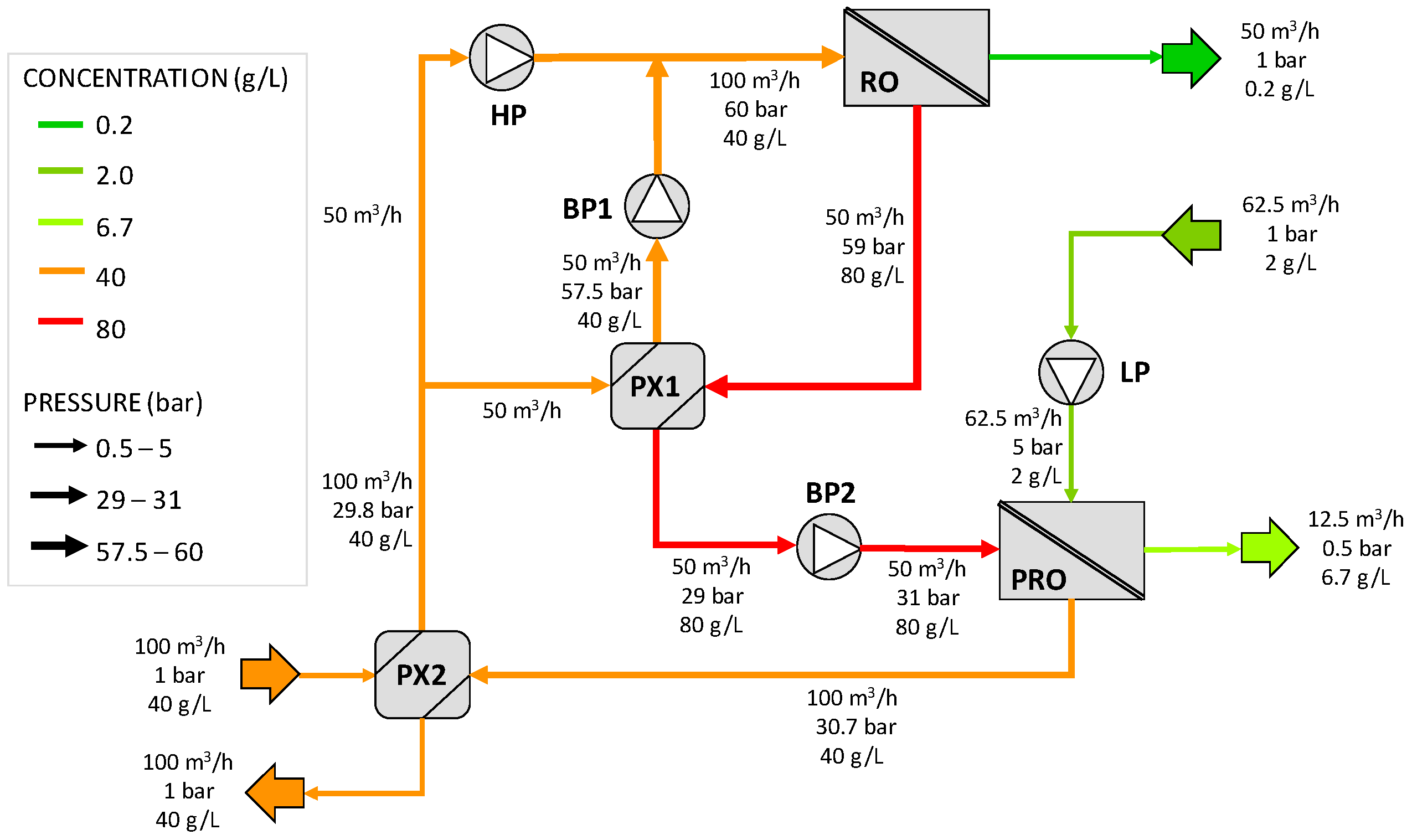

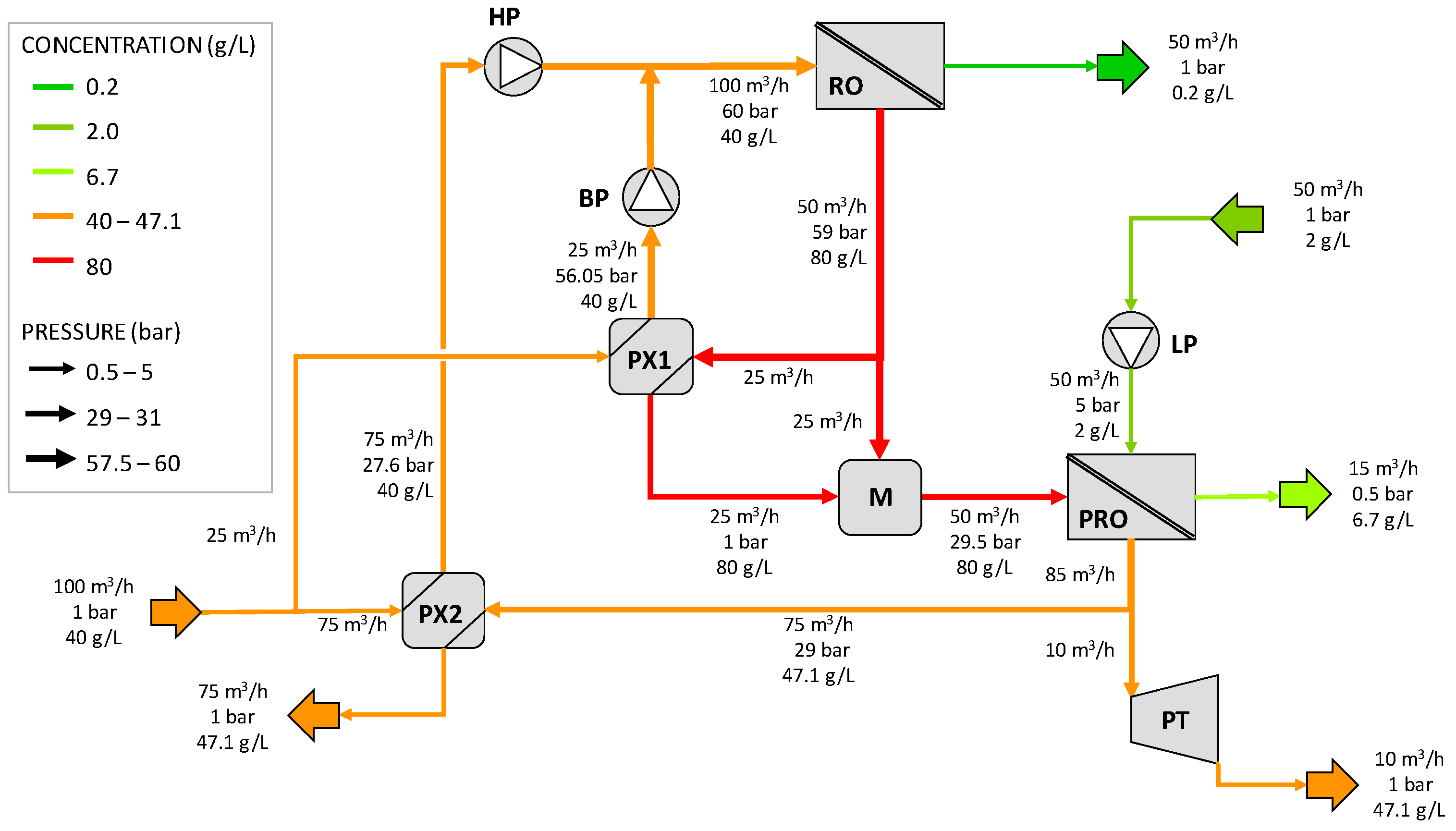
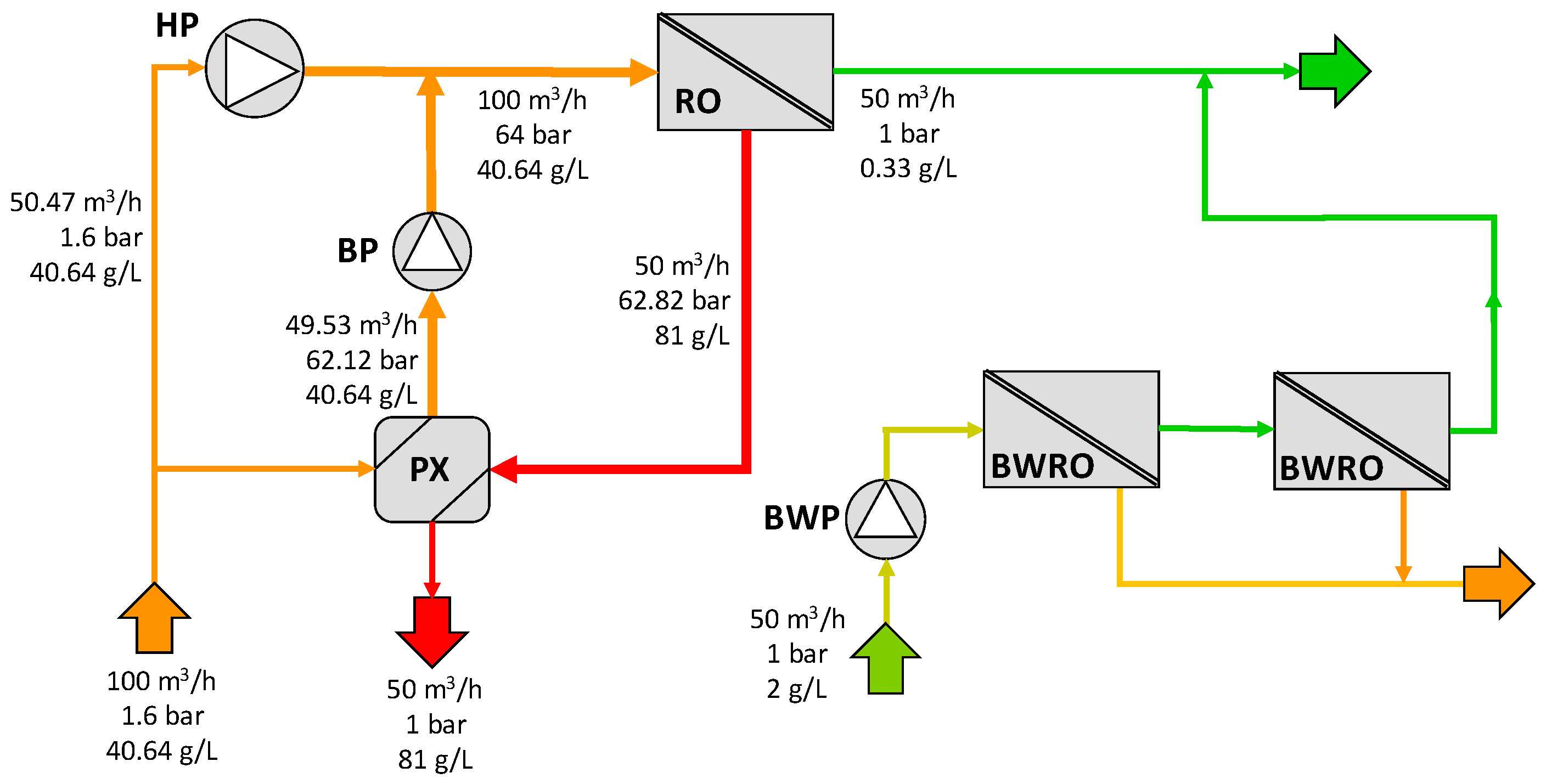
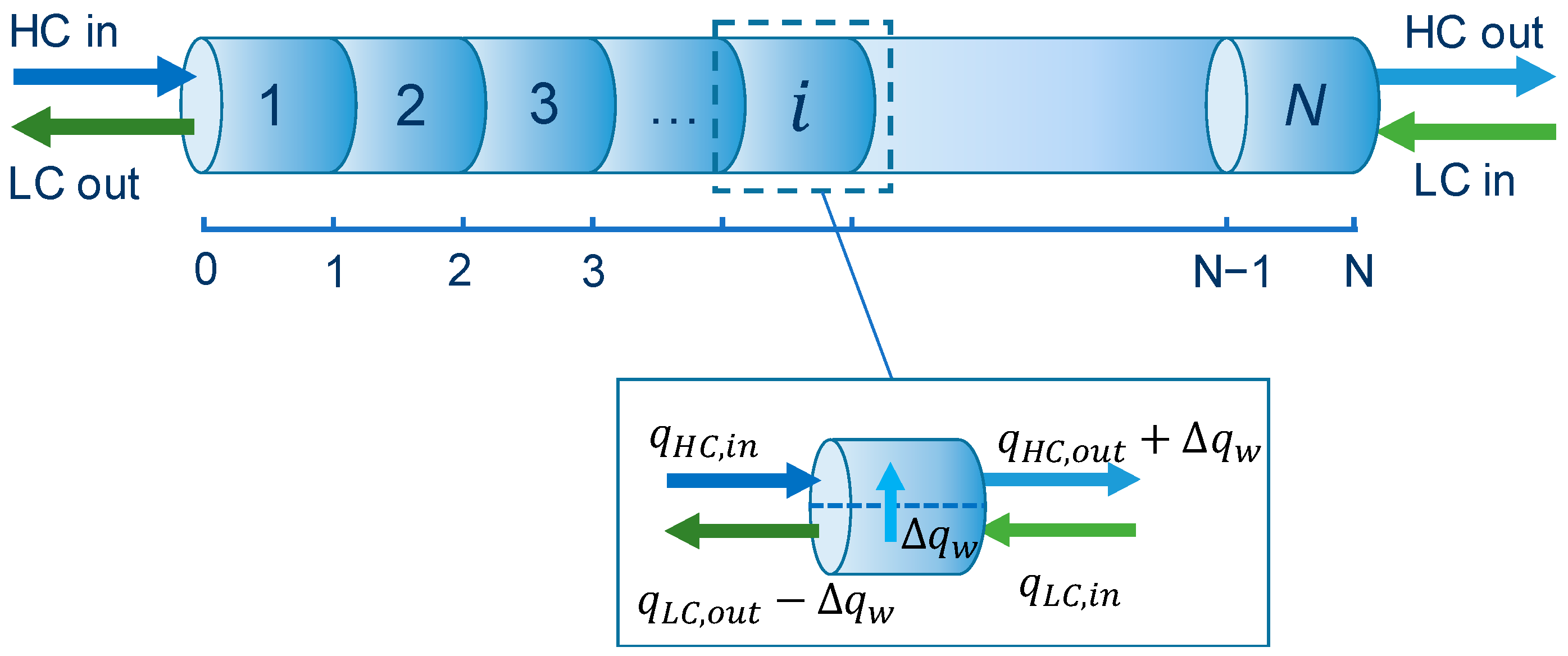



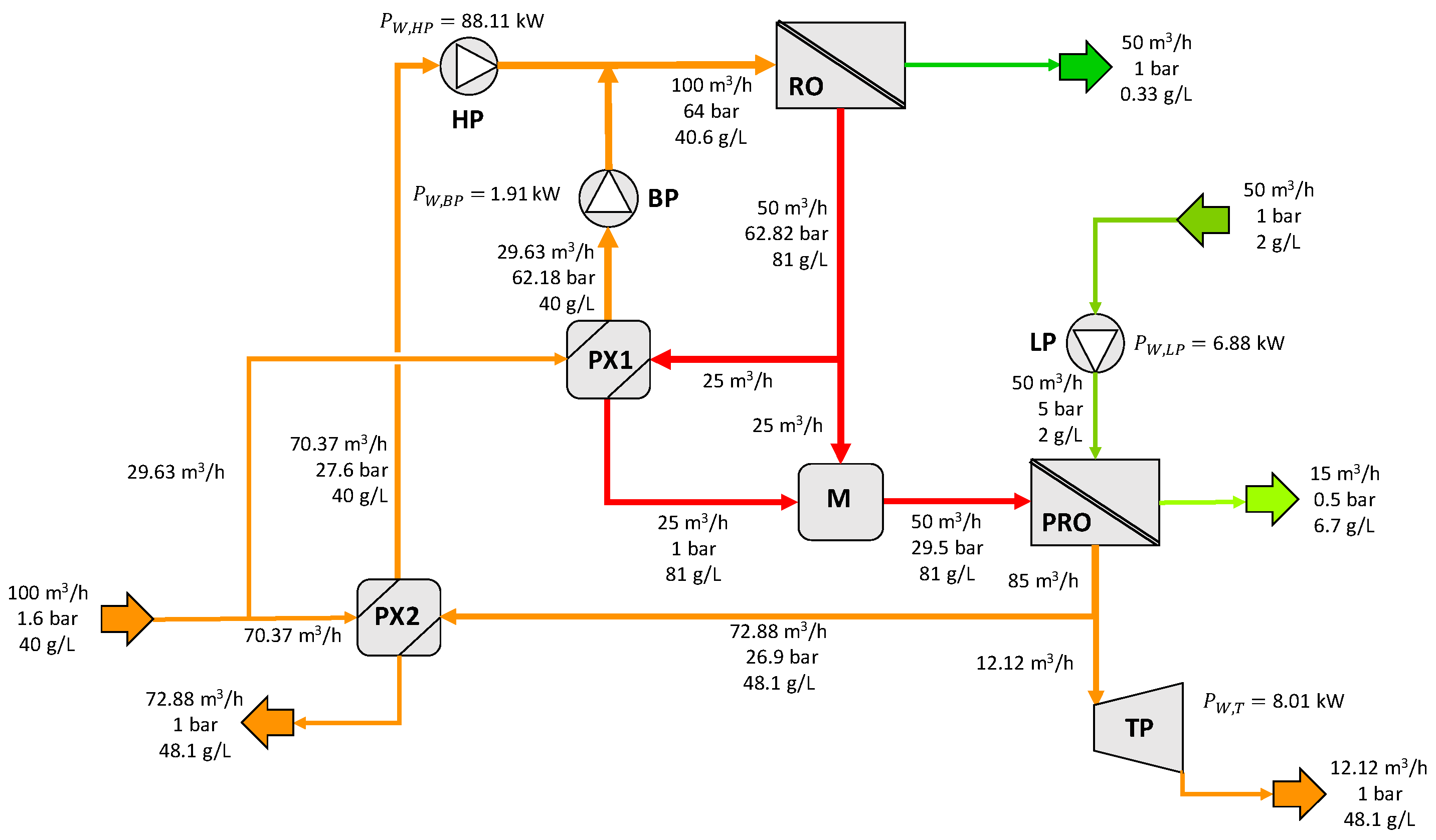
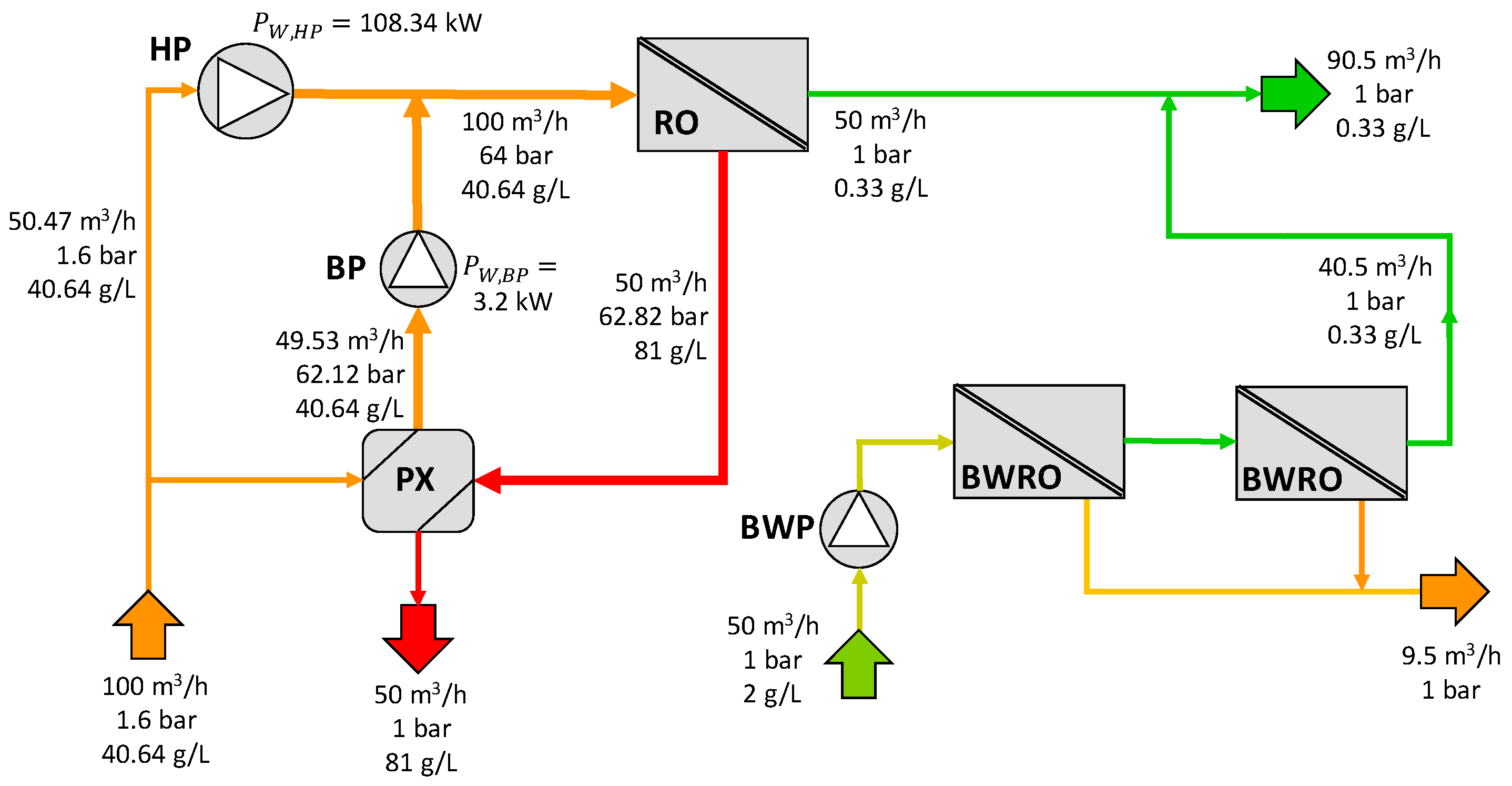
| Reference | SEC Reduction * | SWRO RR | Comment |
|---|---|---|---|
| Altaee et al. [24] | −31% (3.3 vs. 4.8 kWh/m3) | 50% | The layout proposed relies on feed seawater dilution through the PRO system. SWRO feed 45 g/L. Since no energy recovery device is considered, results concerning energy saving in actual SWRO plants cannot be obtained. |
| Prante et al. [25] | −40% (1.2 vs. 2 kWh/m3) | 50% | The layout analyzed consists of using the PRO system as an additional energy source that is placed between two conventional energy recovery devices, with scarce information about the pumps. An SEC of 1 kWh/m3 could be reached with high-performing membranes, 50% RR. |
| Achilli et al. [26] | −49.7% (2.64 vs. 5.25 kWh/m3) | 30% | Three configurations were assessed: standalone SWRO, SWRO-PX (isobaric pressure exchanger), and SWRO-PRO. The latter includes a valve to expand the brine at the SWRO membrane rack prior to the PRO subsystem. Therefore, it should be less energy efficient than that reported in the previous reference. RR of 20% and 30%; SWRO feed 35–37 g/L. |
| Kim et al. [27] | −50% (1.1 vs. 2.2 kWh/m3) | 50% | The energy consumption of a PRO-RO hybrid scheme combining wastewater reuse and seawater desalination is analyzed, where the PRO unit was selected to replace an FO module for feedwater dilution before entering the SWRO membrane elements. |
| Kurihara et al. [28] | −30% | 60% | “Mega-ton Water System”: a large-capacity (106 m3/d) SWRO process for seawater desalination and wastewater treatment system (Japan). PRO used as an energy recovery system. |
| Choi et al. [29] | −20% (2.37 vs. 2.96 kWh/m3) | 40% | A performance and economic analysis of the SWRO-PRO desalination process is presented, using treated wastewater as an FS. Capacity of 100,000 m3/d, and a seawater salinity of 32 g/L. The hybrid scheme was found to be competitive with the standalone SWRO desalination process only for a high price of electricity, low price of PRO membranes, and a high-power density. |
| Senthil and Senthilmurugan [30] | −49.3% (0.842 vs. 1.66 kWh/m3) | 23% | The simultaneous production of electricity and water is analyzed. They reported a theoretical assessment and optimization of the performance of six different SWRO-PRO hybrid schemes for energy recovery from the SWRO brine. The lowest SEC with respect to the stand-alone was the SWRO-PRO configuration with direct mixing of the draw solution outlet and the SWRO feedwater, using wastewater as the feed of the PRO unit, an FS inlet concentration of 0.1 g/L and production at 0.054 m3/s. |
| Wan and Chung [31] | −49.8% (1.14 vs. 2.27 kWh/m3) | 50% | The reduction of energy consumption in the SWRO-PRO desalination process is assessed. Three schemes were evaluated: stand-alone SWRO process, SWRO with two pressure exchangers, and SWRO with two pressure exchangers and PRO, with SECs of 4.13, 2.27, and 1.14 kWh/m3, respectively. The configuration studied is similar to that analyzed by Prante et al. [25]. |
| Wan and Chung [32] | −49.7% (0.98 vs. 1.95 kWh/m3) −48.7% (1.17 vs. 2.28 kWh/m3) | 25% 50% | Four SWRO hybrid processes with PRO and FO: open-loop PRO-SWRO, closed-loop PRO-SWRO, SWRO + FO dilution of the brine, and seawater dilution FO + SWRO. |
| Wang et al. [33] | −42.5% (1.57 vs. 2.73 kWh/m3) a −53.5% (1.27 vs. 2.73 kWh/m3) b | 50% | The impact of the operating temperature on the SEC of the PRO-SWRO system with two ERDs has been evaluated, being the PRO subsystem placed between the ERDs. Increasing the operating temperature from 25 to 50 °C reduces the SEC by 14.41% (0.6 M NaCl solution as the DS) and 17.93% (1.2 M NaCl solution as the DS). |
| Bargiacchi et al. [34] | −8% (~1.68 vs. 1.831 kWh/m3) | 35% | The effect of PRO on the decrease in energy consumption in two different SWRO-PRO configurations is evaluated, using both commercial and experimental hollow fiber membranes and two feed-draw pairs: seawater-brine (35–60 g/L) and brackish-brine (5–60 g/L). |
| Lee et al. [35] | −25% (4.17 vs. 3.13 kWh/m3) | Results of the two-year operation of a 240 m3/d SWRO-PRO pilot plant in Korea are presented, within the GMVP project [36], aimed to demonstrate the technical feasibility of the PRO process to extract salinity gradient energy from the brine of a desalination plant. |
| Ions | g/L × 103 |
|---|---|
| Potassium (K+) | 485.34 |
| Sodium (Na+) | 12,310.05 |
| Magnesium (Mg2+) | 1571.05 |
| Calcium (Ca2+) | 487.36 |
| Carbonate (CO32−) | 32.24 |
| Bicarbonate (HCO3−) | 160.57 |
| Chloride (Cl−) | 22,398.76 |
| Fluoride (F−) | 1.39 |
| Sulphate (SO42−) | 3157.78 |
| Silica (SiO2) | 1.61 |
| Boron (B) | 5.03 |
| Concept | Value |
|---|---|
| Feed Flow to Stage 1, m³/h | 100 |
| Feed Pressure, bar | 64 |
| Flow Factor | 0.85 |
| Total Active Area, m² | 3719.7 |
| Recovery rate, % | 50 |
| Feed Temperature, °C | 28 |
| Feed TDS, mg/L | 40,635 |
| Average Pass 1 Flux, L/(m2·h) | 13.44 |
| Osmotic Pressure: | |
| Feed, bar | 29.08 |
| Concentrate, bar | 60.75 |
| Element | SW30XLE-440i |
| #PV | 13 |
| #Ele | 7 |
| Number of Elements | 91 |
| Conc Flow, m³/h | 50 |
| Conc Press, bar | 62.8 |
| Perm Flow, m³/h | 50 |
| Perm Press, bar | 1 |
| Perm TDS, g/L × 103 | 331 |
| Stream | Patent | This Work | ||||
|---|---|---|---|---|---|---|
(m3/h) | (bar) | (g/L) | (m3/h) | (bar) | (g/L) | |
| SWRO brine (HC in) | 50 | 31 | 80 | 50 | 31 | 80 |
| Diluted brine (HC out) | 100 | 30.7 | 40 | 103 | 30.7 | 40 |
| Feed in (LC in) | 62.5 | 5 | 2 | 62.5 | 5 | 2 |
| Feed out (LC out) | 12.5 | 0.5 | 6.7 | 9.5 | 0.5 | 13 |
| Stream | Patent | This Work | ||||
|---|---|---|---|---|---|---|
(m3/h) | (bar) | (g/L) | (m3/h) | (bar) | (g/L) | |
| SWRO brine (HC in) | 50 | 31 | 80 | 50 | 31 | 80 |
| Diluted brine (HC out) | 85 | 30.7 | 47 | 87 | 30.7 | 47 |
| Feed in (LC in) | 50 | 5 | 2 | 50 | 5 | 2 |
| Feed out (LC out) | 15 | 0.5 | 6.7 | 12.9 | 0.5 | 7.7 |
| Stream | Patent | This Work | ||||
|---|---|---|---|---|---|---|
(m3/h) | (bar) | (g/L) | (m3/h) | (bar) | (g/L) | |
| SWRO brine (HC in) | 50 | 29.5 | 80 | 50 | 29.5 | 80 |
| Diluted brine (HC out) | 85 | 29 | 47 | 87 | 29 | 47 |
| Feed in (LC in) | 50 | 5 | 2 | 50 | 5 | 2 |
| Feed out (LC out) | 15 | 0.5 | 6.7 | 12.9 | 0.5 | 7.7 |
| Concept | Config. A | Config. B | Config. C | Config. D | |
|---|---|---|---|---|---|
| System | SWRO-PRO | SWRO-PRO | SWRO-PRO | SWRO-BWRO | |
| Feed flow rate (m3/h), 40 g/L | 100 | 100 | 100 | 100 | |
| Permeate (m3/h), 0.32 g/L | 50 | 50 | 50 | 90.5 | |
| Recovery rate (%) | 50 | 50 | 50 | 50% SWRO 81% BWRO | |
| PRO FS | Vol. flow (m3/h) | 62.5 | 50 | 50 | 50 |
| Salinity (g/L) | 2 | 2 | 2 | 2 | |
| Pressure (bar) | 1 | 1 | 1 | 1 | |
| Pumping power (kW) | 76.9 | 87.48 | 96.9 | 111.58 | |
| Pelton turbine (kW) | n/a | n/a | −8.01 | n/a | |
| BWRO SEC (kWh/m3) | n/a | n/a | n/a | 0.5 | |
| Total SEC (kWh/m3) | 1.54 | 1.75 | 1.78 | 1.46 * | |
Publisher’s Note: MDPI stays neutral with regard to jurisdictional claims in published maps and institutional affiliations. |
© 2022 by the authors. Licensee MDPI, Basel, Switzerland. This article is an open access article distributed under the terms and conditions of the Creative Commons Attribution (CC BY) license (https://creativecommons.org/licenses/by/4.0/).
Share and Cite
Aumesquet-Carreto, M.-Á.; Ortega-Delgado, B.; García-Rodríguez, L. Opportunities of Reducing the Energy Consumption of Seawater Reverse Osmosis Desalination by Exploiting Salinity Gradients. Membranes 2022, 12, 1045. https://doi.org/10.3390/membranes12111045
Aumesquet-Carreto M-Á, Ortega-Delgado B, García-Rodríguez L. Opportunities of Reducing the Energy Consumption of Seawater Reverse Osmosis Desalination by Exploiting Salinity Gradients. Membranes. 2022; 12(11):1045. https://doi.org/10.3390/membranes12111045
Chicago/Turabian StyleAumesquet-Carreto, Miguel-Ángel, Bartolomé Ortega-Delgado, and Lourdes García-Rodríguez. 2022. "Opportunities of Reducing the Energy Consumption of Seawater Reverse Osmosis Desalination by Exploiting Salinity Gradients" Membranes 12, no. 11: 1045. https://doi.org/10.3390/membranes12111045
APA StyleAumesquet-Carreto, M.-Á., Ortega-Delgado, B., & García-Rodríguez, L. (2022). Opportunities of Reducing the Energy Consumption of Seawater Reverse Osmosis Desalination by Exploiting Salinity Gradients. Membranes, 12(11), 1045. https://doi.org/10.3390/membranes12111045








